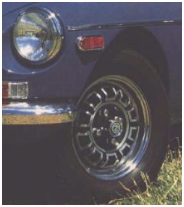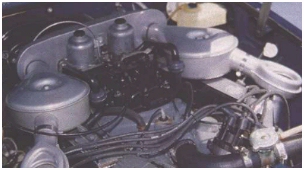 Click here to add your MG News.
Click here to add your MG News.
 Click here to add your MG News.
Click here to add your MG News.
My wife thinks I'm nuts. Let me correct that ....she knows I'm nuts. After all, who in their right mind would sell a 35,000-mile 5-year old MX-5 Miata, a car that was reliable, comfortable, and paid for, to provide partial payment for a 21-year-old, 80,000 mile MG with the usual idiosyncrasies? The only possible explanation for such aberrant behaviour is that the MG in question is a factory-built MGB-GT V8, one of only about 2,600 such cars, with only 12 or so examples in North America. I think my wife Karen had some inkling of the significance of this car, since she didn't put up a really big fuss (even though this car will give me yet another excuse not to mow the lawn). The acquisition of the V-8 is the fulfilment of a 15-year dream, ever since I got to drive one in 1981.
 Click on the image to see the whole vehicle |
 Click on the image to see the whole engine bay |
The only external signs of its larger engine are the discreet V8 badges on the tail, grille, and front fenders. The car even draws admiring glances and thumbs up from American muscle car drivers, who normally would sneer at one of them leetle furrin' cars .
What prompted British Leyland to drop a V-8 into the GT and not the roadster, and why were so few of them built? We may never know all the answers.
The MGB bodyshell was originally designed around a 2,000cc V-4 (shades of Saab!), but production problems shelved this engine. As a result, the engine bay and bonnet design were wide enough to accept a V-type engine, even though the 4-cylinder engine was used.
The acquisition of Rover when British Leyland was formed in 1968 made the all-aluminium 3500 cc Rover V-8 (ex Buick/Oldsmobile 215) a part of the family and available to MG. But British Leyland was not about to jump in and make the same mistake that they did with the MGC. Poor reviews by the press resulted in slow sales of that larger engined MG, and only 9,000 or so were built.
It took the actions of a privateer to convince British Leyland to build a factory MGB-GT V-8. The stage was set when a man named Ken Costello began constructing Rover V-8 engined MGB's starting in 1970. Favourable road test reports of the Costello cars in British automobile magazines must have aroused British Leyland's curiosity. In 1971 they supplied Costello with a new MGB-GT and a Rover V-8, and asked him to convert the car to V-8 power. After studying the car that Ken built, Leyland promptly cut off Costello's supply of new Rover V-8s (by requiring that any new V-8 engine would only be sold if a core was taken in return).
The Leyland Version
Soon Leyland built a prototype of their own, developed in four weeks on a shoestring budget. The production version was launched in August, 1973. No convertible versions were offered. The factory apparently was worried about scuttle shake in the roadster bodyshell, so they limited production to the GT. Subsequent private V-8 MGB conversions have proven this would not have been a problem.
The car as produced by Leyland was very well received by the British motoring press, the smoothness of the engine and improved acceleration were strong points. (Motor obtained 0-60 mph in 7.6 seconds, as compared to 11.5 in the standard MGB-GT). The majority of the road testers did comment that the interior appointments should have been improved over the standard MGB-GT, and that wind noise was excessive for this class of car.
They also complained that the GT V-8 didn't look different enough from the 4 cylinder cars. In their view, if someone shelled out a premium for the car, they should be able to stand out from the crowd. This was partly the fault of the MG designers, who developed a special low profile intake manifold and air filter assembly, which nestled the twin SU 1 3/4 carburettors down far enough to eliminate any Boy Racer' bonnet bulges.
At the time of the release of the car, Abingdon fully intended to offer it for sale in the USA. To this end, 7 pre-production versions of the car were built to full Federal left-hand-drive standards, with emission-controlled engines. These were sent over here for testing and exhibition at dealers across the country.
After this tour (which created an incredible interest among the dealers) Leyland inexplicably pulled the plug on potential US sales. The official explanation was that there wasn't enough capacity at the Rover plant to build enough engines to satisfy US production volume. The 7 Federal cars were sent back to England and were subsequently sold to European customers.
In retrospect, there may have been other reasons why the car wasn't sold here in the US. The first possibility is that the car was released just as the first Arab oil embargo and subsequent gas crisis occurred. Suddenly cars with V-8 engines were unpopular, everyone wanted econboxes. Another plausible reason is that Leyland had their hands full in preparing for the certification of the 1974-1975 rubber bumper MGs for the US market. This effort was necessary to continue selling cars in the US, and cost Leyland a great deal of money. There wasn't much cash left over to consider certifying a completely new model for the US.
The final reason that has been proposed is that Leyland was reluctant to offer the V-8 in the US for fear of offending General Motors. Rover had bought the rights to build the 3500 V-8 from GM, and maybe they felt that the B-GT V-8 would have taken away sales from the Corvette. Unlikely, but possible. Whatever the reasons, we in the US were not offered the V-8 through the dealer network. As it was, the V-8 was only produced through 1976, the high price and competition from cars like the Ford Capri resulted in the early demise of the car often only 2,591 were built.
The only examples that made it to the US were brought over as gray market cars by private individuals. My car was one of the few to be brought in during the 1980s. My sketchy records indicate that it came to the US in 1984, sold to a fellow in Colorado named McAdams. The car then went to Gene Ponder in Texas, where it was sold at auction in 1990. The next owner brought it to California, kept it until 1995, when it came to me.
I discovered the car at the 1995 Dixon British Car Show. It turned out that the owner lived only about 5 miles from my home in Fair Oaks, near Sacramento, CA. After an extended conversation about the car, I left the owner with the usual if you ever decide to sell this car, call me spiel, and never expected a reply. Suffice it to say that he DID reply, and after several months of negotiations and monetary juggling (including selling the aforementioned Miata) Number GD2D-1 889G is now safe in my care.
The car looks good to the untrained eye, but it is a prime example of what went wrong in the car hobby during the late 80s, early 90s. The car was given an lauction restorationl with a very nice (but non-standard) blue leather interior, and a new (non-standard) blue paint job that hides a multitude of sins, including the dreaded tinworm. I knew all this before I bought the beastie, but felt that its rarity will justify the work to strip it to a bare shell and return it to its original Teal Blue paint and Autumn Leaf interior.
Driving the V8
What's it like to drive? In a word, satisfying. I have owned many 4-cylinder MG's, and have always felt that they needed a bit more power (but not at the expense of handling). The aluminium V-8 engine only weighs 14 pounds more than the original cast-iron MGB engine, so the balance is maintained. There is a skosh more understeer than is evident in a 4-cylinder B, but nothing like the Massey-Ferguson style handling of other British V-8 hybrids like the Sunbeam Tiger. With approximately 140 horse power on tap you can have lots of fun with your throttle foot, particularly in wet weather. I'm just itching to get this car on a skidpad! Freeway hole shots are also effortless, taking far less planning to get around all those awful minivans and SUVs.
If there is one area that suffers compared to the 4-cylinder cars, it is ride quality. The factory had no money to redesign the rear suspension when they built the V-8, so they put on a set of police spec rear springs to handle the expected axle tramp. This makes things rough, particularly on bad roads. This is probably the only MG built that is most at home on smooth freeways, it would have sold like hotcakes here in California.
The car is shown here at the 1996 Dixon British Car Show, the first anniversary of that fateful day that brought me and 889G together. Ilve decided to begin a complete restoration to get rid of the rust and return the car to original condition. I'm currently in parts acquisition mode, one of my favourite tasks. Since about 20% of the parts are unique to the V-8, I get to enjoy the thrill of the hunt.
Nocturnal calls to England, package delivery trucks wearing a groove in my street, and odd V-8 bits stacking up inside the house (at least I confine them to my study, Karen would frown on exhaust manifolds in the bedroom). Three UK firms, Beer of Houghton, Burlen Fuel Systems, and Brown & Gammons, have been very helpful in finding the rare bits. I also would like to thank my wife in advance, for putting up with what will probably be an all-consuming two-project. Hmm...maybe if I cut down on fertilizer, the lawn won't need mowing until 1998...
Republished with the kind permission of British Car Magazine
 Back to the News content
Back to the News content
![[Copyright/Credits]](../pics/mini-copyright.gif)
![[Home]](../pics/mini-home.gif)
![[Information]](../pics/mini-info.gif)
![[Feedback]](../pics/mini-mail.gif)